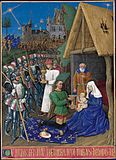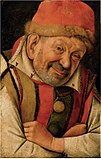art.wikisort.org - Artist
Jean (or Jehan) Fouquet (ca.1420–1481) was a French painter and miniaturist.[1] A master of panel painting and manuscript illumination, and the apparent inventor of the portrait miniature, he is considered one of the most important painters from the period between the late Gothic and early Renaissance. He was the first French artist to travel to Italy and experience first-hand the early Italian Renaissance.
![Jean Fouquet, self-portrait (1450). The earliest portrait miniature, and possibly the earliest formal self-portrait.[lower-alpha 1]](http://upload.wikimedia.org/wikipedia/commons/thumb/5/51/Jean_Fouquet.png/260px-Jean_Fouquet.png)
Little is known of Fouquet's early life and education. Though long assumed to have been an apprentice of the so-called Bedford Master of Paris it is now suggested that he may have studied under the Jouvenal Master in Nantes, whose works were formerly assumed to be early works by Fouquet. Sometime between 1445 and 1447 he travelled to Italy where he came under the influence of Roman Quattrocento artists such as Fra Angelico and Filarete. During the 1450s he began working at the French court, where he counted kings Charles VII and his successor Louis XI among his many patrons.
Life
He was born in Tours. Little is known of his life, but it is certain that he was in Italy before 1447, when he executed a portrait of Pope Eugene IV, who died that year. The portrait survives only in copies from much later.
Upon his return to France, while retaining his purely French sentiment, he grafted the elements of the Tuscan style, which he had acquired during his period in Italy, upon the style of the Van Eycks, forming the basis of early 15th-century French art and becoming the founder of an important new school.[1]
He worked for the French court, including Charles VII, the treasurer Étienne Chevalier, and the chancellor Guillaume Jouvenel des Ursins. Near the end of his career, he became court painter to Louis XI.
His work can be associated with the French court's attempt to solidify French national identity in the wake of its long struggle with England in the Hundred Years' War.[2]
One example is when Fouquet depicts Charles VII as one of the three magi. This is one of the very few portraits of the king. According to some sources, the other two magi are the Dauphin Louis, future Louis XI, and his brother.
- Paintings of the French court
- The burial of Étienne Chevalier
- Charles VII as one of the three magi.
- Entry of Charles V in Paris on 2 August 1358, Grandes Chroniques de France (1455-1460)
- Marriage of Charles IV and Marie of Luxembourg
- From Grandes Chroniques de France illustrated by Jean Fouquet, 1455-1460 Paris
Works

Fouquet's excellence as an illuminator, his precision in the rendering of the finest detail, and his power of clear characterization in work on this minute scale secured his eminent position in French art. His importance as a painter was demonstrated when his portraits and altarpieces were for the first time brought together from various parts of Europe for the exhibition of the "French Primitives" held at the Bibliothèque Nationale in Paris.[1]
His self-portrait miniature would be the earliest sole self-portrait surviving in Western art, if the 1433 portrait by Jan van Eyck—usually called Portrait of a Man or Portrait of a Man in a Turban—is not in fact a self-portrait, as some art historians believe.

Far more numerous are his illuminated books and miniatures. The Musée Condé in Chantilly contains forty miniatures from the Hours of Étienne Chevalier, painted in 1461 for Chevalier. Fouquet also illuminated a copy of the Grandes Chroniques de France, for an unknown patron, thought to be either Charles VII or someone else at the royal court.[3][4] Also from Fouquet's hand are eleven of the fourteen miniatures illustrating a translation of Josephus at the Bibliothèque Nationale. The second volume of this manuscript, unfortunately with only one of the original thirteen miniatures, was discovered and bought in 1903 by Henry Yates Thompson at a London sale, and restored by him to France.[1]
One of Fouquet's most important paintings is the Melun Diptych (c. 1450), formerly in the Collegiate Church of Notre Dame, Melun. The left wing of the diptych depicts Étienne Chevalier with his patron saint St. Stephen, and is now in the Gemäldegalerie, Berlin. The right wing shows a pale Virgin and Child surrounded by red and blue angels and is now at the Royal Museum of Fine Arts, Antwerp. Since at least the seventeenth century, the Virgin has been recognized as a portrait of Agnès Sorel.[5]
The Louvre has his oil portraits of Charles VII, of Count Wilczek, and of Guillaume Jouvenel des Ursins, and a portrait drawing in crayon.[1]
The National Library of France has illuminated parchment manuscripts which recount the history of the Jewish people from Creation to the outbreak of the Jewish revolt against the Romans in A.D. 66.
Gallery
- Annunciation
- King David and the Amalekite, as described in Antiquities of the Jews by Flavius Josephus
- Construction of the Temple of Jerusalem
- Pompey in the Temple of Jerusalem, as described in Antiquities of the Jews by Flavius Josephus
- The Martyrdom of Saint Apollonia
- Book of Hours
- Portrait of the Chancellor of France, Guillaume Jouvenel des Ursins, Musée du Louvre, Paris
- Portrait of the Court Jester Pietro Gonnella, Kunsthistorisches Museum, Vienna
- Pieta of Nouans Church of Nouans-les-Fontaines
- Copy of the lost Portrait of Pope Eugene IV
- Illustration from c. 1450 that depicts the cathedral of Notre-Dame with the rest of Paris in the background
See also
- Melun Diptych
- Book of Hours of Simon de Varie
References
Notes
- As opposed to the artist inserting a small portrait of himself into a much larger religious scene. A 1433 painting by Jan van Eyck (Portrait of a Man) is widely believed to be a self-portrait.
Citations
- Chisholm 1911.
- Inglis 2011.
- "Grandes Chroniques De France". Bibliothèque nationale de France. Retrieved November 18, 2011.
- Inglis 2003, pp. 185–224.
- Snyder 1985, p. 247.
Sources
- This article incorporates text from a publication now in the public domain: Chisholm, Hugh, ed. (1911). "Foucquet, Jean". Encyclopædia Britannica. Vol. 10 (11th ed.). Cambridge University Press. p. 737.
- Inglis, E. (2003). "Image and Illustration in Jean Fouquet's Grandes Chroniques de France". French Historical Studies. 26 (2): 185–224. doi:10.1215/00161071-26-2-185. ISSN 0016-1071. S2CID 163091918.
- Inglis, Erik (2011). Jean Fouquet and the Invention of France: Art and Nation After the Hundred Years War. Yale University Press. ISBN 978-0-300-13443-8.
- Snyder, James (1985). Northern Renaissance Art: Painting, Sculpture, the Graphic Arts from 1350 to 1575. Prentice-Hall. ISBN 978-0-13-623596-5.
Further reading
- Gillet, Louis (1909). . In Herbermann, Charles (ed.). Catholic Encyclopedia. Vol. 6. New York: Robert Appleton Company.
- Josephus. Antiquités judaïques [Jewish Antiquities] (in French). hdl:loc.wdl/wdl.3030.
External links
- Encyclopædia Britannica
- Bibliothèque nationale de France - Jean Fouquet, Painter and Illuminator of the XVth Century (smaller English version)
- Bibliothèque nationale de France - Jean Fouquet, peintre et enlumineur du XVe siècle (full French version)
- Fouquet's decorations for the Book of Hours of Simon de Varie Manuscript 74 G 37. Koninklijke Bibliotheek National Library of the Netherlands
На других языках
[de] Jean Fouquet
Jean Fouquet (* um 1420 in Tours; † zwischen 1478 und 1481) war ein französischer Buch- und Tafelmaler. Er gilt als einer der bedeutendsten Künstler an der Schwelle von der Spätgotik zur Frührenaissance.- [en] Jean Fouquet
[es] Jean Fouquet
Jean Fouquet (Tours, Francia; h. 1420-Tours, h. 1481) es considerado uno de los grandes pintores del Renacimiento inicial y el renovador de la pintura francesa del siglo XV. Formado en la tradición francesa del gótico internacional, desarrolló un nuevo estilo, integrando las fuertes tonalidades cromáticas del gótico con la perspectiva y los volúmenes italianos, así como la innovación naturalista de los flamencos. Sus obras maestras son el Díptico de Melun y las miniaturas del Libro de horas de Étienne Chevalier.[fr] Jean Fouquet
Jean Fouquet, né vers 1420, peut-être à Tours (France), et mort entre 1478 et 1481, probablement dans la même ville, est considéré comme l'un des plus grands peintres de la première Renaissance et le rénovateur de la peinture française du XVe siècle.[it] Jean Fouquet
Jean Fouquet[1] (Tours, 1420 circa – 1481) è stato un pittore e miniatore francese, massimo rappresentante della pittura del suo paese nel XV secolo.[ru] Фуке, Жан
Жан Фуке (фр. Jean Fouquet; Тур, ок. 1420 — 1481) — французский живописец, первый мастер французского Возрождения, портретист и миниатюрист, глава Турской школы.Другой контент может иметь иную лицензию. Перед использованием материалов сайта WikiSort.org внимательно изучите правила лицензирования конкретных элементов наполнения сайта.
WikiSort.org - проект по пересортировке и дополнению контента Википедии















